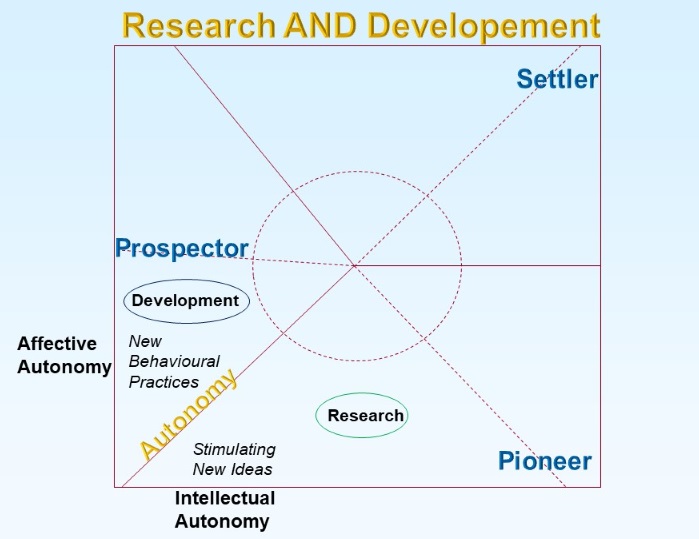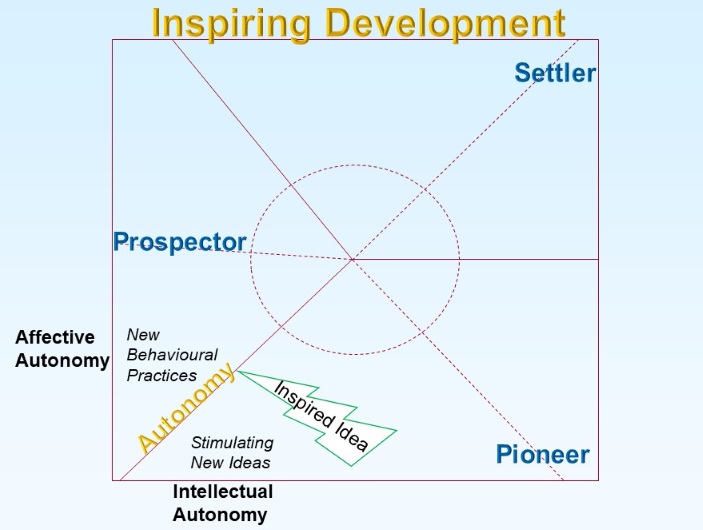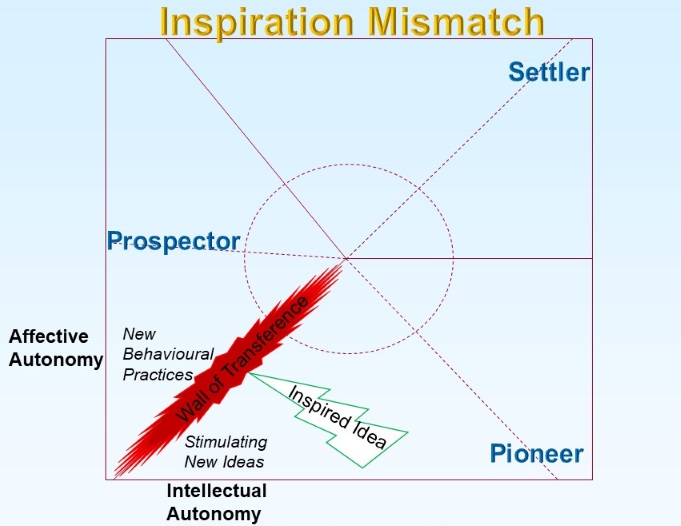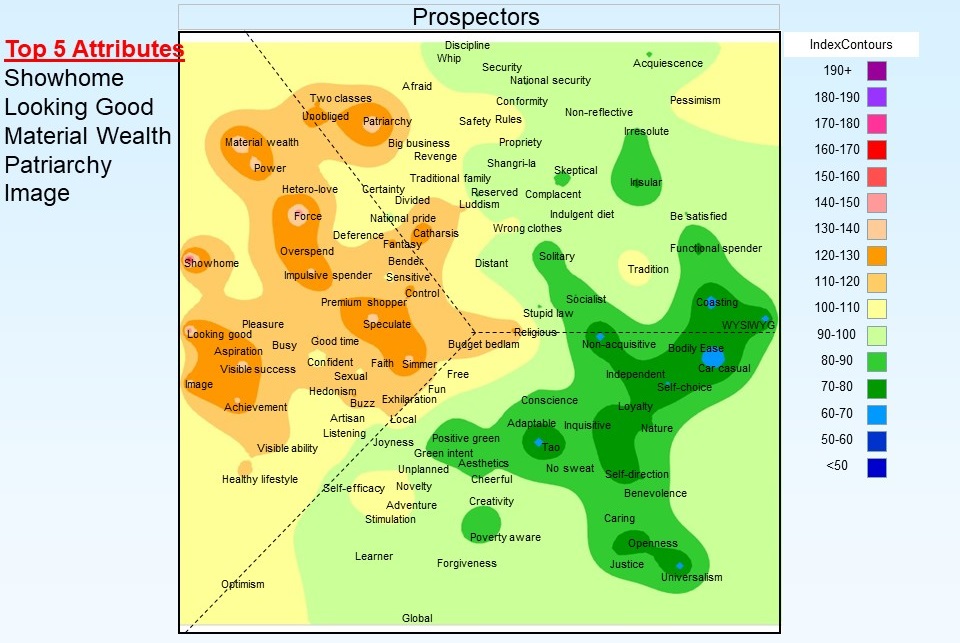

'Great Minds Create Great Solutions' - Part Three
After great ideas comes great execution.
This is often the first chokepoint in the innovation process - great ideas, driven by the dynamics of different values sets hitting the 'The Wall of Transference'.
This wall can occur when the great ideas or concepts are transferred to other teams, who are responsible for other duties in the development of ideas into innovations, not being as inspired by the great idea(s).
Our research has shown that Pioneers often make up the majority in many work groups charged with developing new concepts or products. Research has also shown that Prospectors are often in charge of production processes that bring concepts and great ideas into reality - from the initial physical creation of a product to the design and delivery of a marketing process or service.

At the root of all great innovations or unique insights into established practices is an individual or group that has the autonomy to develop new ideas and concepts. This form of autonomy is facilitated by the corporate architecture, to think 'different thoughts and do different things'. These people or groups will use the autonomy to challenge themselves and others to see the world differently. The ideas and concepts are developed and refined until they are inspired to share the idea with others.
In a corporate setting this is the point at which 'their baby' is passed over to more specialist developers charged with taking the concept to production or application. At that stage of R+D, the group, rooted in intellectual autonomy, needs to let go of their ideal concept. They must also take responsibility for inspiring people who are likely to have a very different values set - one that values affective autonomy - to do things their way.

Great ideas should inspire great products, processes and services BUT ...
The power of great ideas can be stymied by the Wall. On one side of the wall is Pioneer-driven inspiration and on the other side are specialists with Prospector perceptions, who may have had little to part in generating the idea or concept but are now charged with its development.
As specialists in development they are often highly trained and motivated to solve problems. They will use a combination of thinking and doing that is built on past expertise but also remain open to new methods and processes appropriate to each new challenge.
The challenge of finding solutions demands that they are self-starting pragmatists. They are likely to be inspired to take on the project and work at it until it is solved - that is the way they have developed their expertise and place in the corporate team.
In some circumstances the work is truly challenging - it taxes personal and group resources - and for the most part is welcomed as worthy of their efforts. Prospectors want to be seen to be the best and a big challenge creates the conditions for them to produce high profile results that others can admire. However, in other circumstances the innovative project handed to them may not be perceived as 'just another idea, nothing to get excited about'.
In other words, they will take on the new project, but will not be inspired to the same extent as the Pioneers. They may even reject the inspirational presentation of the Pioneers. This neutral or negative proception may result in them judging this inspired Pioneer idea or concept as 'not worth the effort' and give it just enough time to finish the project - with no 'ownership' of the result.

This is often manifested in R+D departments, but also in brain-storming session (apparently one should no longer use that term but what the heck!), or other processes - from formal board meetings to informal water-cooler moments; wherever people meet and exchange ideas.
Transference of inspired ideas and concepts can seem simple on a corporate organigram or a GANTT chart - a straight line from concept creation to concept development - from R to D. Nothing could be farther from the truth. This brings us to another insight we've discovered in our research and consultancy.
Inspiration is Values Dependent
What inspires a Pioneer, may inspire a Prospector but only in a limited way at best. Often it will be wholly uninspiring to a Prospector. Similarly, something that inspires a Prospector may inspire a Pioneer but is more likely to leave the Pioneer wanting more - i.e. it's not inspiring.
Note: The same dynamic clash occurs between any pair of the three values groups - Prospectors, Pioneers and Settlers. What inspires one group is unlikely to inspire the other, although it may.
Without this basic insight, leaders and teams charged with innovation and the development of new concepts into work product (products, services, policies, etc.) can expend a lot of resource for very little or no result.
Breaking Through the Wall of Transference
Our research has shown that Pioneers discover and develop new ideas based on factors within their values system - as do Prospectors and Settlers. This means that the motivating factor for sifting and selecting new ideas are different for each group. This has implications when ideas and concepts are passed from one group to another.
The content and style of information transference will be likely be passed to other groups in the language of the group that discovered/developed the idea. The group would have been inspired to 'let the world know about their idea' and, in all good faith, frame their communications and presentations in a way that has inspired them - because they want others to be as inspired as they are to bring the idea into reality.
This will work in most organizations at one time or another; but if there is a repeating clash-dynamic it is likely because it was not:
- anticipated.
- understood.
- addressed.
- used for improved delivery and profitability.
Anticipated
Great companies learn from their experiences, and feedback is the most useful tool to define what was missed in the previous effort to improve a systemic process. One of the most frequent learnings is the failure to anticipate failure. The optimism bias is a large part of the source of failure and, as optimism is a significant factor for both Pioneers and Prospectors, this is something that must be controlled for within any development of innovative and creative solutions to business issues. Management tools like 'best case/worst case' scenarios and 'pre-mortums' can help control this natural bias between and within teams.
Understood
This is where so many good business tools fail to become great tools to help users identify and understand the root causes of many failures. Analytic and diagnostic tools, often driven by economic and behaviour based data and records, can get teams to understand the 'who, what, where, when and how' questions. Less robust, in some cases useless, they attempt to help with the 'why' and 'why not' questions like:
- Why did our team love the idea and the others hate it?
- Why do their standards seem so low?
- Why aren't they inspired? It is a great idea!
- Why not just give up now?
Just looking at and understanding the most differentiating Attributes of the CDSM Pioneers and Prospectors Maps will give people with different values systems a basis for powerful analysis and diagnosis in many situations - in terms that indicate why things failed in the past and suggest grounds for success in the future.
Pioneer Values

(Right click on the image and select "View image"
to see a bigger version).
A team comprised of people with this values-set will be inspired by ideas outside their own national cultures and social networks.
They will be attracted to social issues and want to know the details of any problems brought about by social ills. Their inspired innovations will often be based on making the world a better place. Their personal and group ethics will often drive their solutions.
They will be relaxed about how others view them. They are content to live and let live. They may or may not be aware of the reasons their ideas are often seen as 'one step too far', or 'ahead of its time', i.e. not 'common sense'.
In their own minds they want others to be as excited about new ideas as they are - and the more different and 'out there' the better.
Their version of inspired communications and presentations will either be very detailed and full of connections or stripped right back to the bare bones - the essence of the inspiration. But it is just as unlikely to fit a corporate format or adhere to 'best practice' formats.
To Prospectors this can look and feel 'weird' and 'unusual', not normal and certainly not inspiring!
Addressed
The innovation part of R+D may have run up against the wall of transference but by addressing the issue in a people focused way it can be breached.
The Prospectors, who also want to be inspired, are just not inspired by the same things as the Pioneers. But, by knowing what inspires Prospectors, the Pioneers can communicate with them in a Prospector manner - honouring their values rather than ignoring them.
When Pioneer innovators pay attention to the top five Attributes in the Prospector values system, they will have the ability to address the Prospectors in a manner that inspires them.

(Right click on the image and select "View image"
to see a bigger version).
The people holding this set of values are not driven by the same things as the blue sky thinkers - they are much more pragmatic and goal orientated.
They see their jobs as a way to achieve status - through doing great things and being seen to be the people responsible for great results. They differ in many ways from Pioneers. They aren't as patient as Pioneers and expect to be set an objective and a due date, so that they can exceed expectations of both quality and delivery date. Their drive for the success of any project is tied into their self-image as winners. They will see as inspirational the T-shirts and posters in their areas with slogans like "Failure is Not an Option", "Move Fast and Break Things"" and "Show me a gracious loser and I'll show you a loser". Prospectors love to win. Show them a way to win and they will be inspired to work harder, faster and take no prisoners in their drive for the a successful outcome. The valuable fruits of their labours are perceived in terms of image, prestige, money and power over others.
Healthy companies combine these orientations. Creating cultures that are balanced in terms of human needs is important.
Used for greater quality and profitability.
No project runs 100% to plan - reality has a way of intruding on the best laid plans. Sub-optimal results often stem from human factors rather than structural faults.
Being able to understand and address human factors makes it more likely that complex projects, requiring coordination between teams, will be less likely to fail.
Knowledge and use of human factors, like values system analysis and application, not only creates an awareness of others' beliefs and motivations - it also leads to greater self-awareness.
This combination of greater self-knowledge and knowledge of others is a potent mixture that can be self-sustaining in supportive cultures. In these cultures of conscious dynamic improvement great quality is the inevitable result.
How do you find out the Values of your teams and begin creating an optimal results?
Contact Pat Dade at mail@cultdyn.co.uk to discuss Values profiling your team(s).
As a quick alternative please call 0207 744 2546.
Cultural Dynamics Strategy & Marketing Ltd.
email: mail@cultdyn.co.uk
tel: +44 (0)208 744 2546